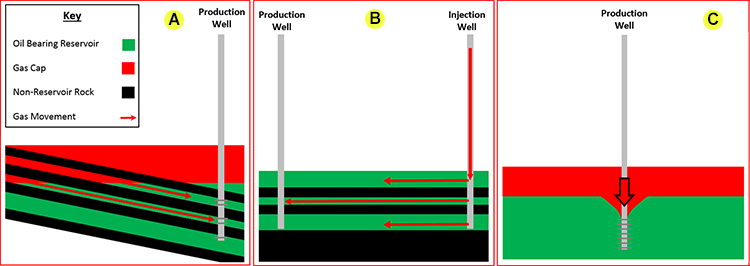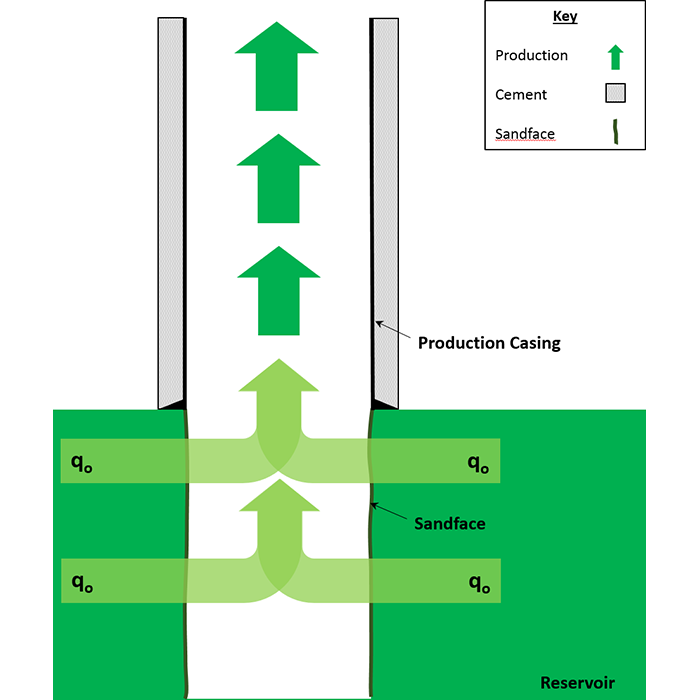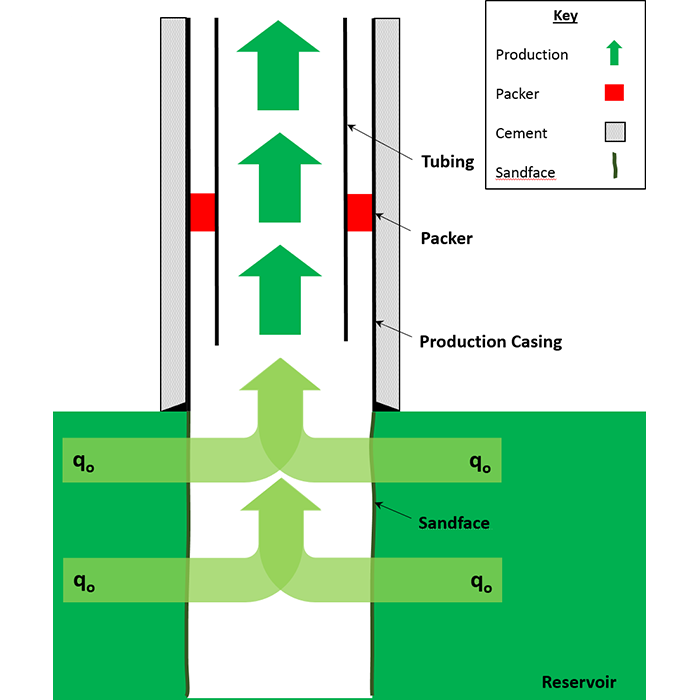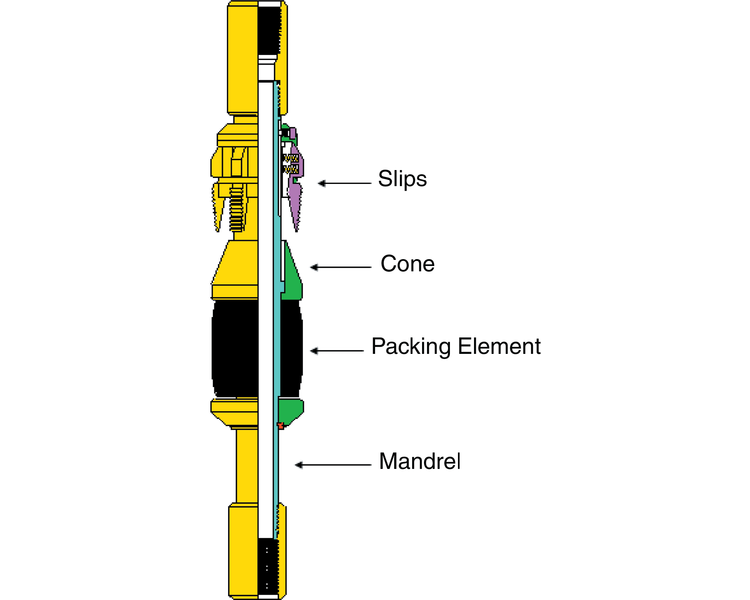The least complex and least costly well completion is a Barefoot, Open-Hole completion. An open-hole completion is a completion that does not have any casing or tubulars cemented across the reservoir section, while a barefoot completion has no tubulars, casing or tubing, across the reservoir section (a barefoot completion is a subset of an open-hole completion). Two examples of barefoot, open-hole completions are shown in Figure 7.07, one without tubing and one with tubing.

(A) Production Well with Lateral Gas Production from the Gas Cap.
(B) Production Well with Lateral Gas Production from the Injection Well.
(C) Production Well with Gas Coning from the Gas Cap.
As with all decisions on completion design, there are advantages, disadvantages, and trade-offs associated with each decision regarding the open-hole, barefoot completions.
The advantages of a barefoot, open-hole completion include:
- they are the least expensive completion technique;
- they are adaptable to special drilling techniques that minimize reservoir damage (wells can be drilled to the top of the reservoir, casing set and cemented in place, and drilling/completion fluids changed to less damaging fluids for drilling through the reservoir);
- no perforating expenses;
- no issues with open-hole logging (time-lapse open-hole logs can be run for improved reservoir characterization and surveillance);
- large wellbore radius, , across the reservoir (From Lesson 4 and Lesson 5, we saw that a large wellbore radius improves Productivity Index and Inflow Performance – Table 7.01 and Table 7.02 have been reproduced to illustrate this point and to aid in later discussions);
- large diameter conduit to surface which results in lower pressure losses in high production rate wells (in Lesson 6, we saw that the pressure losses were significantly impacted by the the inner diameter of the conduit to the flow);
- the well can be easily deepened if desired;
- the completion can be modified at a later date with an inner casing string or liner if desired.
The disadvantages of a barefoot, open-hole completion include:
- as illustrated, sand production cannot be permanently controlled without a Major Rig Workover, MRWO (an expensive well intervention requiring a drilling rig and hoist). Temporary sand control can be performed with multiple bailer/clean-out well interventions (less expensive Slickline Workover). We will discuss Major Rig Workovers, Coiled Tubing Workovers, Wireline Workovers, and Slickline Workovers later in this lesson;
- as illustrated, excessive gas or water production cannot be easily controlled;
- selective well stimulation (acidizing or hydraulic fracturing of specific depth(s) in the reservoir) more difficult than with Cased and Perforated Completions;
- while the large diameter conduit for fluids flowing to the surface has the advantage of lower pressure losses, it has the disadvantage of lower velocity for the same volumetric rate. If the velocity of multiphase flow is too low, then the heavier fluids may segregate toward the bottom of the well causing a segregated water phase across the reservoir.


From the lists of advantages and disadvantages for barefoot, open-hole completions, we can see that these well completions would typically target reservoirs locations with limited chance of production of sand or unwanted fluids. These completion designs also illustrate that a field-wide well completion to be used on each and every well may not be desirable. For example, production wells close to a source of gas or water (see Figure 7.05 and Figure 7.06) may not be good candidates for the barefoot open-hole completions shown in Figure 7.07, while wells in the same reservoir down-dip from the gas cap or up-dip from the aquifer may be suitable candidates for these completions. In terms of sand control, the well completions shown in Figure 7.07 normally target hard, consolidated reservoir rocks.
There are several features of the well completions shown in Figure 7.07 that require further discussion. One common feature to these well completions is that there are no tubulars (casing or tubing) across the sandface. By definition, this is what makes these two completions barefoot completions. A second common feature to these completions is that casing has been set at the top of the reservoir. There are several reasons for running and setting this casing. These include:
- preventing reservoir fluids from entering porous and permeable formations above the reservoir;
- preventing heavier fluids from porous and permeable formations above the reservoir from entering the reservoir;
- preventing rock material and drilling debris from formations above the reservoir from entering the wellbore and settling across the reservoir sandface;
- preventing catastrophic wellbore collapse and loss of the well.
As seen in Figure 7.07, we can run a barefoot completion with or without a tubing string. Again, there are advantages and disadvantages to running a tubing string.
The advantages of running a tubing string include:
- the tubing permits for easy Circulation of fluids (corrosion inhibitors, scale inhibitors, solvents, Workover Fluids, or Kill Fluids) down the tubing and up the annulus (or Reverse Circulating fluids down the annulus and up the tubing). By running a tubing string without a production packer, we are setting up a three-dimensional U-Tube for these circulation process. Note, there are ways to circulate fluids with the temporary installation of Coiled Tubing (spooled tubing capable of being run into the well with the use of a drilling rig).
- provides multiple flow paths for artificial lift systems.
- protects the casing from erosion, corrosion, abrasion, or excess pressures.
- provides a means for monitoring bottom-hole pressures.
The disadvantages of running the tubing string in the completion in Figure 7.07 (B) are:
- the cost of the tubing;
- the rig time required to run the tubing:
- costs involved in paying the Day Rate for the rig;
- deferred production and revenue from the well.
Even the decision to run or not to run a Production Packer has advantages, disadvantages, trade-offs, and costs associated with it. A packer is device that is used to provide annular isolation for the well (prevent fluid flow through the annular space between the tubing and casing) and to anchor (secure) the tubing string to the production casing.
The advantages of including the production packer in the completion are:
- most common means of providing zonal control (isolation of reservoir layers) used in the industry
- isolates casing leaks or poor cement jobs in the well:
- protects the well from unwanted fluids entering the well;
- protects the subsurface environment from produced fluids exiting the well;
- protects the casing from excess pressure and corrosive fluids;
- protects the tubing from tubing leaks (Without a packer, the annular space between the tubing and casing will be filled with a static gas column while the tubing will be with a flowing liquid. The pressure differential caused by this pressure gradient disparity is conducive to tubing leaks. With a packer, the annular space is filled with a static fluid while the tubing is filled with a flowing fluid. This reduced pressure differential helps to prevent tubing leaks.)
- well safety (in conjunction with sub-surface safety valves)
- supports some of the weight of the tubing string
- some artificial lift systems
Many of these objectives, advantages, and disadvantages will become more clear later in the lesson when we discuss Zonal Isolation.
The disadvantage of running a Production packer are:
- additional cost (packer costs);
- difficulty in Recompleting the Well:
- Retrievable Packers can be easily unseated and removed; however, are much more expensive for the same functionality and less reliable than a permanent packer;
- Permanent Packers are extremely difficult to remove from a well once seated. To remove a permanent packer, the tubing above the packer must be removed (a standard operating procedure in the field), but the permanent packer must be milled out with a drilling rig and special milling bit.
Figure 7.08 is a schematic diagram of a simple, retrievable packer. I am supplying this Petrowiki link in the text (as well as in the reference) because the article contains a lot of good information on well completions and packers. While I was at it, I also provided the link to a Wikipedia article on well completions. The Wikipedia article has a good glossary of terms for much of the equipment that I will be discussing in the remainder of this lesson (and some terms that I will not be discussing). The links to these two articles are:
- PetroWiki Article [1]: Packers
- Wikipedia Article: Completion (Oil and Gas Wells)
Use your mouse wheel to zoom in and out, left mouse button to rotate, and right mouse button to move the model.
In this schematic, the threads at the top and the bottom of the packer are used to couple it to the tubing string. The packing element in the schematic is the element that creates the seal in the annulus. There are many ways that a packer can be actuated. These include:
- mechanical actuation (applying weight from the tubing string and rotating it with the rig). This is the actuation method used in the schematic diagram. Weight from the tubing string causes the sealing element to compress outward forming the seal;
- pressure actuation (inflating the sealing element with pressurized drilling, completion, or work over fluid);
- electrically actuated (inflating the sealing element with an electrically controlled pump – both pump and packer are run at the end of wire line. This method of actuation is typically used for tubing retrievable packer.)
The two links that I supplied provide additional information on the design aspects of production packers. As I mentioned earlier, the completions shown in Figure 7.07, the decision to use a production packer or not may be optional. When we begin to discuss Zonal Isolation, the use of the packers will become required.
As you can see from this discussion, the production engineer must make many decisions for a well completion, even for a completion as basic as that shown in Figure 7.07. The criteria for these decisions were listed in the first bullet list in the Well Design Section: The Overriding Well Design Considerations bullet list. One key aspect of the production engineers’ job is to be kept informed on the latest innovations is sub-surface well technology.
[1] Society of Petroleum Engineers technology website: Petrowiki
